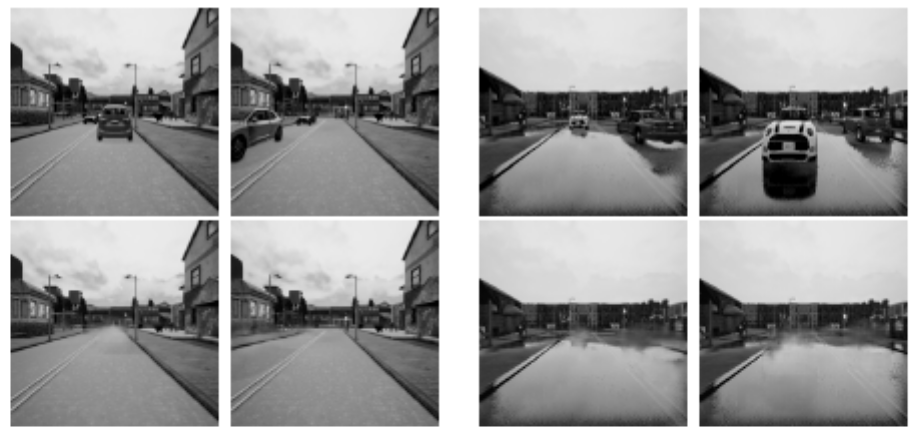Torch implementation for learning a mapping from input images that contain dynamic objects in a city environment, such as vehicles and pedestrians, to output images which are static. In the example below, the top images are fed one by one into our model. The bottom row are the obtained results:
Empty Cities: Image Inpainting for a Dynamic-Object-Invariant Space
Berta Bescos, Jose Neira, Roland Siegwart, Cesar Cadena
- Linux or OSX
- NVIDIA GPU + CUDA CuDNN (CPU mode and CUDA without CuDNN may work with minimal modification, but untested). We used CUDA 8.0 and CuDNN 5. Other versions might work too with minimal modification, but untested.
- Install torch and dependencies from https://github.com/torch/distro
- Install torch packages
nngraphanddisplay(optional)
luarocks install nngraph
luarocks install https://raw.githubusercontent.com/szym/display/master/display-scm-0.rockspec- Clone this repo:
git clone git@github.com:BertaBescos/EmptyCities.git
cd EmptyCitiesYou might need the GitHub package https://git-lfs.github.com/ to clone it.
Pre-trained models are found within the folder /checkpoints.
mGAN: generative inpainting model.SemSeg: semantic segmentation model. The original model from ERFNet has been finetuned with our data.
- You can fastly test our model with one image.
input=/path/to/input/image/ qlua test.luaWe provide some images in /imgs/test you can run our model on. For example:
input=imgs/test/0.png qlua test.luaThese images are from the Cityscapes and the SVS datasets.
- You can also store the inpainted result and the binary mask that has been used.
input=/path/to/input/image/ output=/path/to/output/image/ th test.luaIn the following example the binary mask is stored in /imgs/test/0_output_mask.png:
input=imgs/test/0.png output=imgs/test/0_output.png th test.lua- If the stored mask is not accurate enough, you can provide yourself a better one:
input=imgs/test/0.png mask=imgs/test/0_mask.png output=imgs/test/0_output.png th test.lua- If you want to work with more than one image, we encourage you to keep your data in a folder of your choice
/path/to/data/with three subfolderstrain,testandval. The following command will run our model within all the images inside the foldertestand keep the results in./results/mGAN. Images within the foldertestshould be RGB images of any size.
DATA_ROOT=/path/to/data/ th test.luaFor example:
DATA_ROOT=/path/to/EmptyCities/imgs/ th test.lua- If you prefer to feed the dynamic/static binary masks, you should concatenate it to the RGB image. We provide a python script for this.
DATA_ROOT=/path/to/data/ mask=1 th test.lua- Finally, if the groundtruth images are available you should concatenate them too (RGB | GT | Mask).
DATA_ROOT=/path/to/data/ mask=1 target=1 th test.luaThe test results will be saved to an html file here: ./results/mGAN/latest_net_G_val/index.html.
Our synthetic dataset has been generated with CARLA 0.8.2. Within our folder /scripts/CARLA we provide some python and bash scripts to generate the paired images. The files /scripts/CARLA/client_example_read.py and /scripts/CARLA/client_example_write.py shoule be run instead of the /PythonClient/client_example.py provided in CARLA_0.8.2. Images with different weather conditions should be generated.
- The following bash scripts store the images with dynamic objects in
path/to/dataset/, as well as the control inputs of the driving car and the trajectory that has been followed inControl.txtandTrajectory.txtrespectively. CARLA provides two different towns setups: Town01 has been used for generating the training and validations sets, and Town02 for the testing set.
bash scripts/CARLA/CreateDynamicDatasetTown01.sh path/to/my/folder/bash scripts/CARLA/CreateDynamicDatasetTown02.sh path/to/my/folder/- These scripts read the previous stored
Control.txtfiles and try to replicate the same trajectories in the same scenarios with no dynamic objects. The followed trajectory and the one inTrajectory.txtare compared to check that the vehicle position is kept the same.
bash scripts/CARLA/CreateStaticDatasetTown01.sh path/to/my/folder/bash scripts/CARLA/CreateStaticDatasetTown02.sh path/to/my/folder/- Once all these images are generated, the dynamic images should be stored together in a folder with the subfolders
/train/,/test/and/val/. The same for the static images and for the dynamic/static binary masks. We provide the following bash script:
bash scripts/CARLA/setup.sh path/to/my/folder/ path/to/output/For better adaptation to real world images, we have used the Cityscapes dataset.
- We provide a python script to generate the CARLA training, validation and test data in the needed format. The following script concatenates the images {A,B,C} where A is the image with dynamic objects, B is the groundtruth static image, and C is the dynamic/static binary mask.
python scripts/setup/combineCARLA.py --fold_A /path/to/output/A/ --fold_B /path/to/output/B/ --fold_C /path/to/output/C/ --fold_ABC /path/to/output/ABC/- Also, to format the Cityscapes images we provide the following python script. You should run it for the
/valfolder too.
bash scripts/setup/combineCITYSCAPES.py --fold_A /path/to/CITYSCAPES/leftImg8bit_trainvaltest/leftImg8bit/train --fold_B /path/to/CITYSCAPES/gtFine_trainvaltest/gtFine/train --fold_AB /path/to/output/trainFurther notes: Also, you can download a small dataset from here. Note that this dataset is valid for testing, but it contains very few images for training.
If you use this code for your research, please cite our paper Empty Cities: Image Inpainting for a Dynamic-Object-Invariant Space:
@article{emptycities2018,
title={Empty Cities: Image Inpainting for a Dynamic-Object-Invariant Space},
author={Bescos, Berta and Neira, José and Siegwart, Roland and Cadena, Cesar},
journal={arXiv},
year={2018}
}
Our code is heavily inspired by pix2pix.
